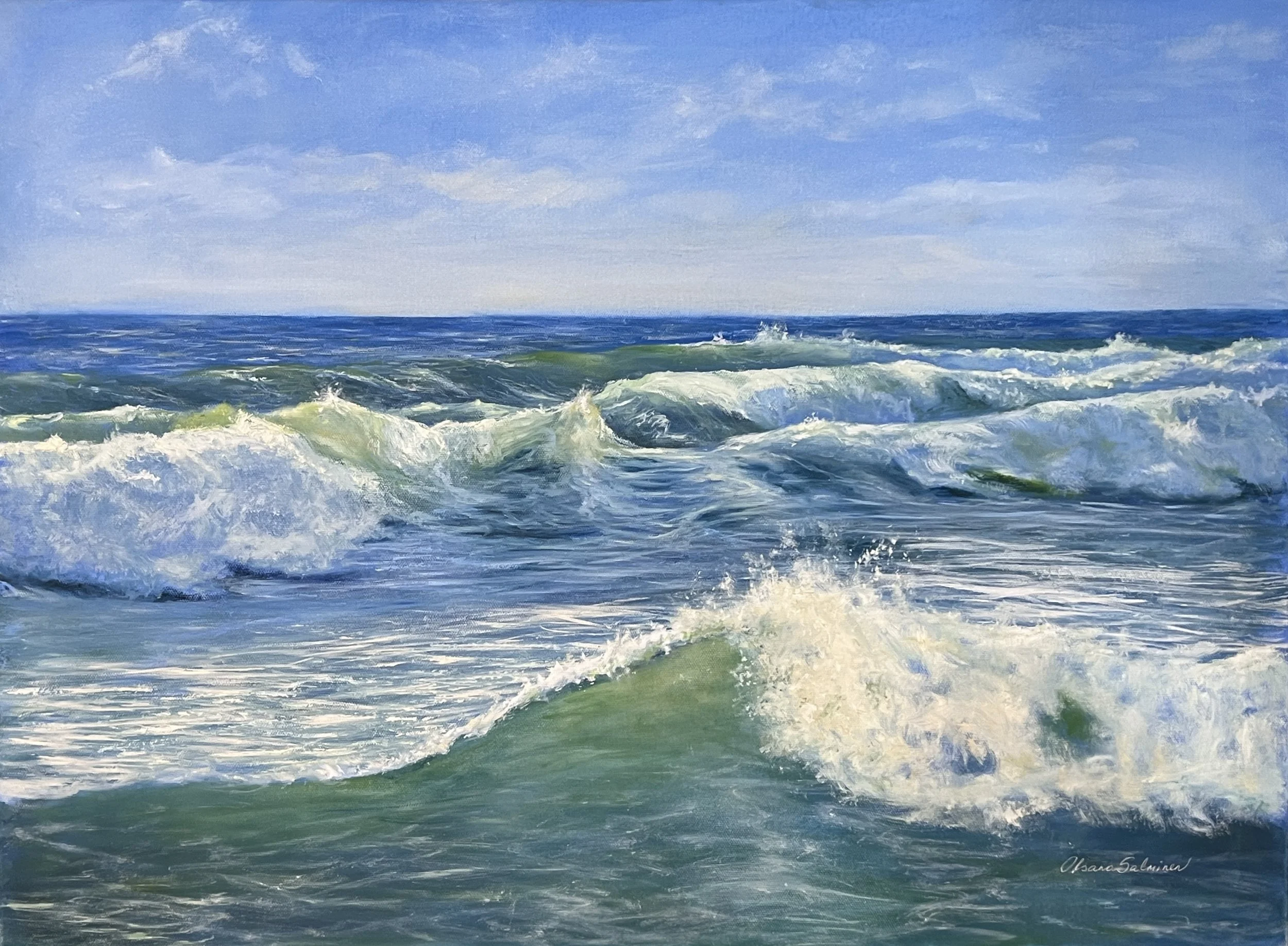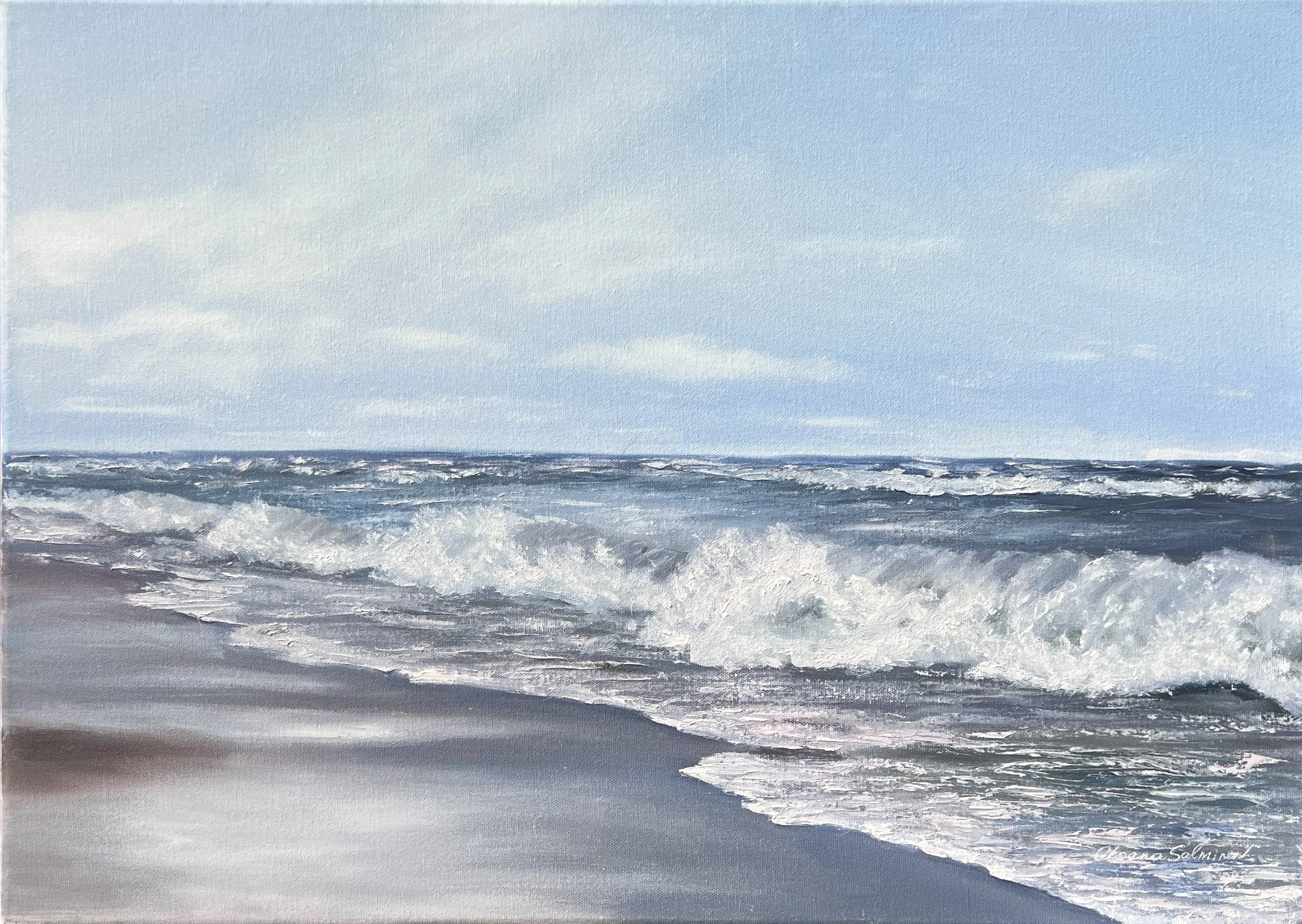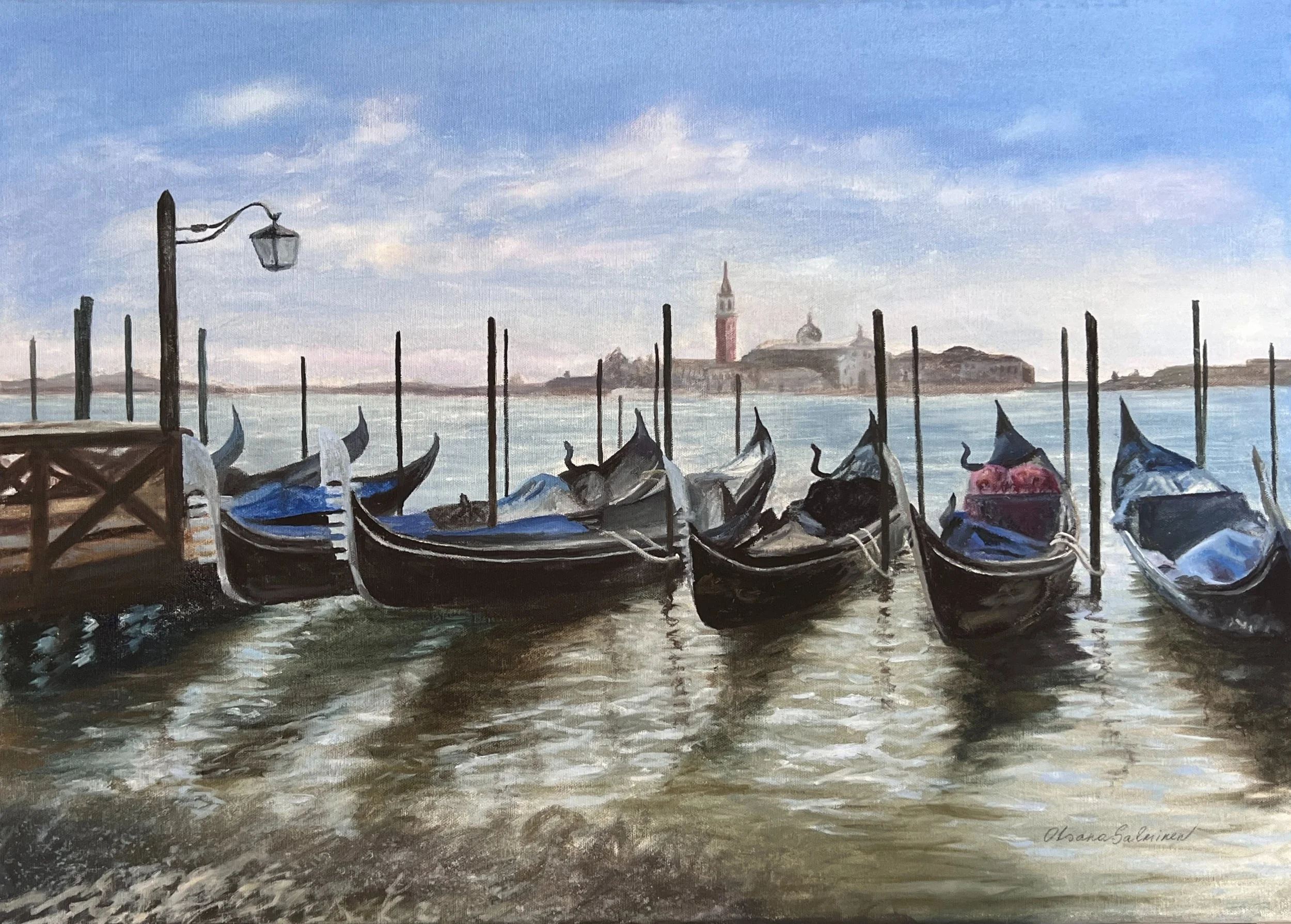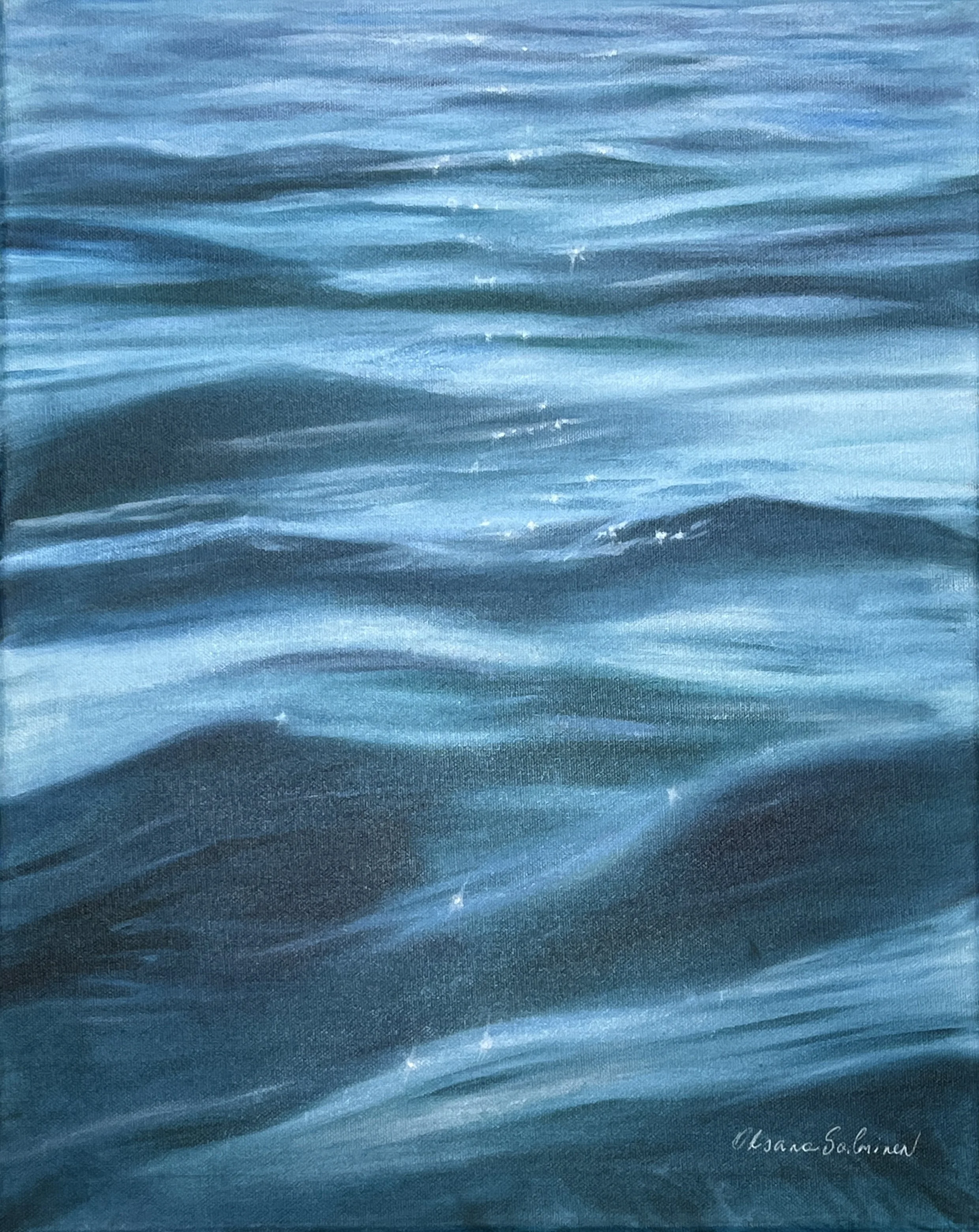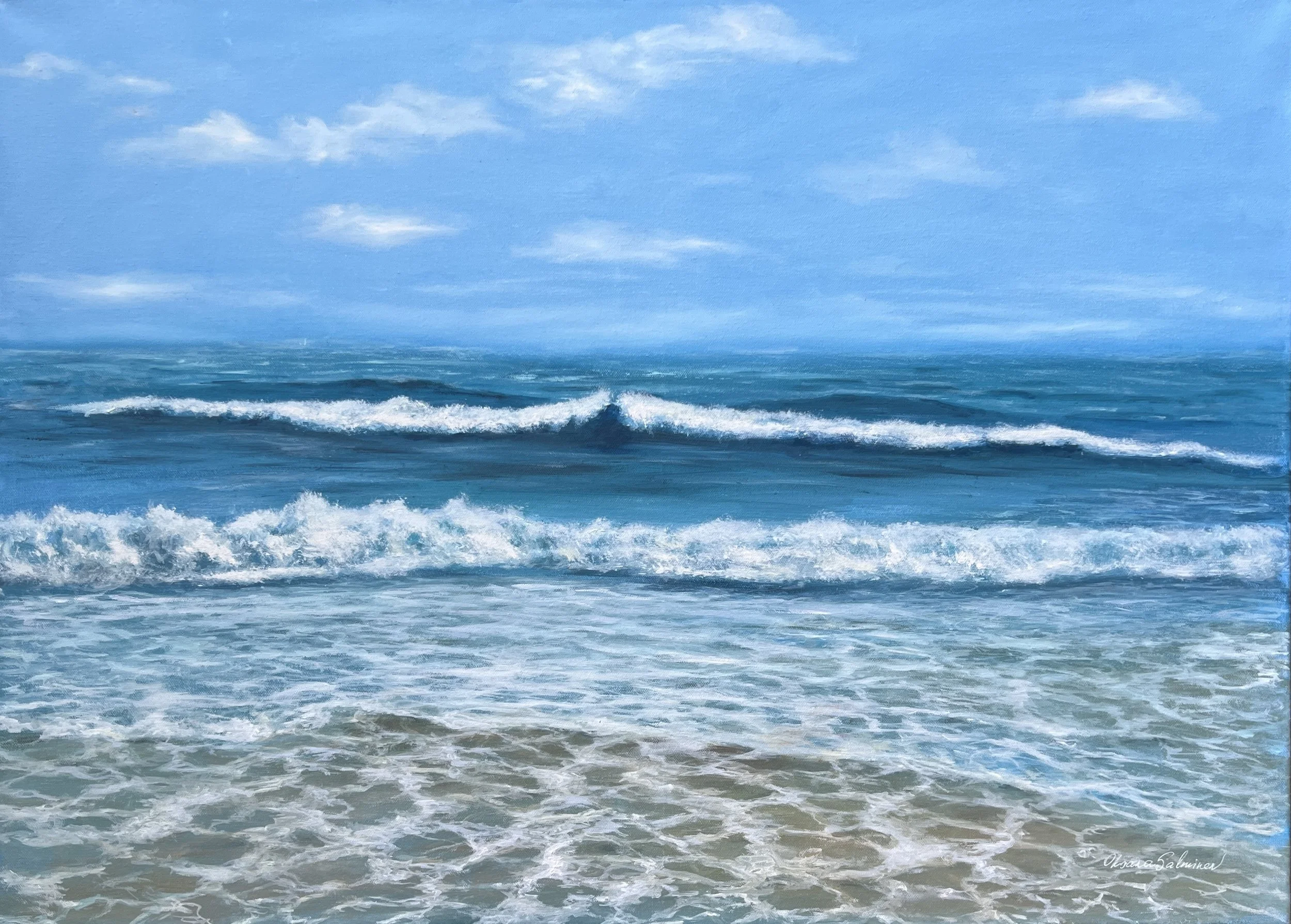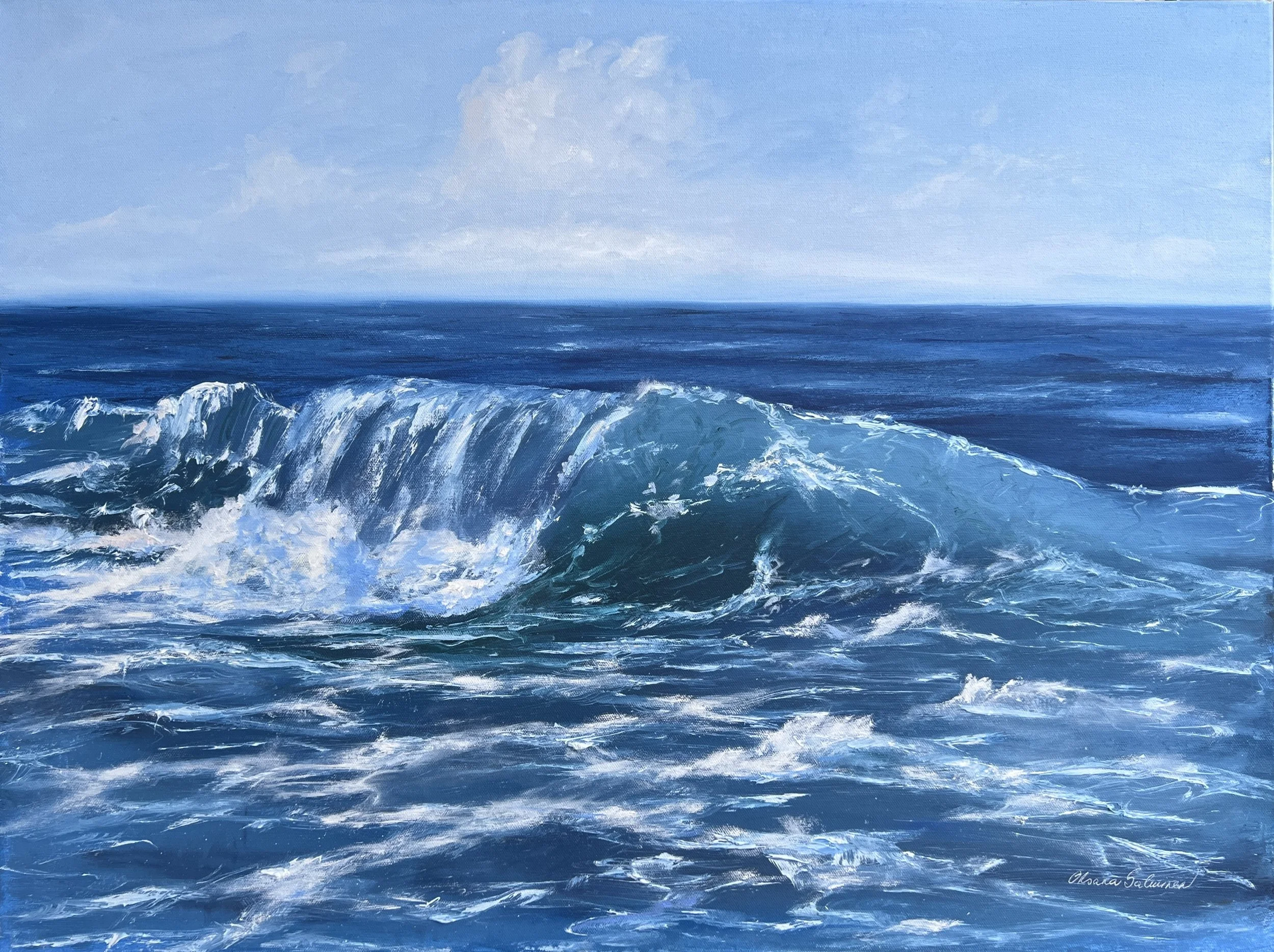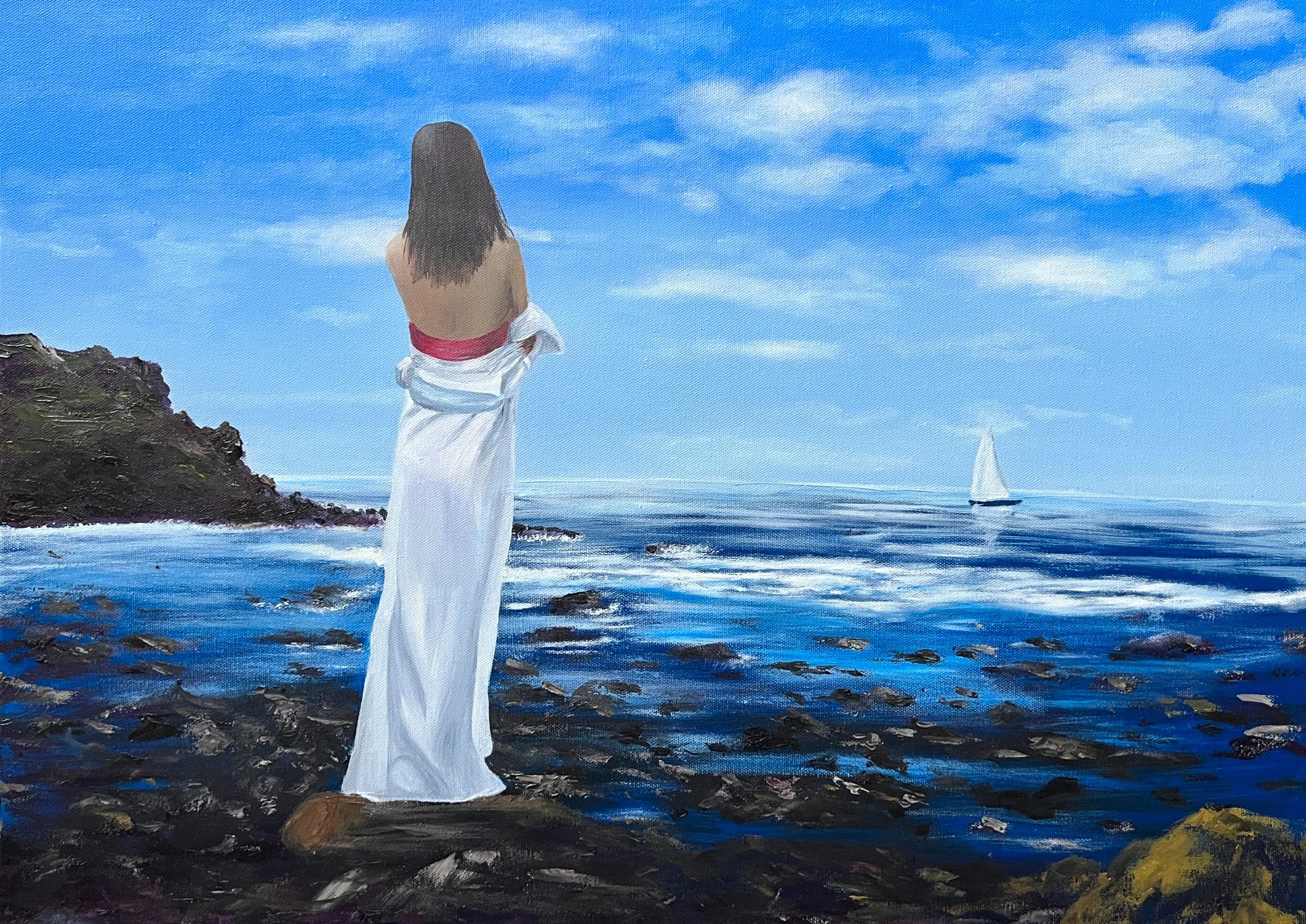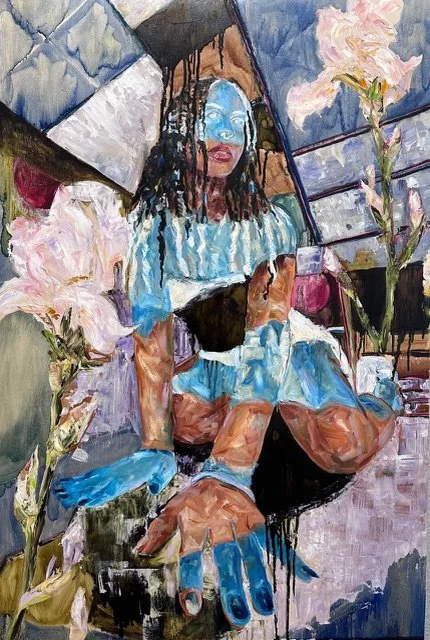Oksana Salminen
In an era of conceptual abstraction and politically charged provocations, there exists a rare and luminous voice that paints not for spectacle but for serenity, who, during the world’s chaos, chooses beauty as a form of resistance. That voice is Oksana Salminen, an award-winning contemporary painter whose brush speaks the gentle, arresting language of the sea, of memory, of joy, and deeply personal hope.
Hailing from the dual heartlands of Finland and Estonia, Salminen lives and creates between two cultures, two coastlines, two visions of Northern beauty. Her work is not merely admired; it is collected, exhibited, and quietly celebrated across Europe and the United States in galleries in Italy, Germany, Spain, the UK, and far beyond. And it is little wonder why. For what she brings to the contemporary art world is not just technical finesse and chromatic brilliance, but an emotional honesty that disarms. Her seascapes and figurative works aren’t just paintings; they are meditative experiences, emotional geographies that linger long after viewing.
Born with an eye for the poetic and an innate sensitivity to the natural world, Oksana’s journey began early. At the age of ten, she won a school art contest, a quiet, fated triumph that led her to the Tallinn Art School, where she studied painting and exhibited to acclaim even as a teenager. Life, however, took her first into the rational realms of finance, law, and psychology. But art like the tide returned, persistent and quietly demanding. Eventually, she answered the call, earning her degree in Fine Arts and devoting herself fully to her creative voice.
And what a voice it is.
One cannot encounter Oksana Salminen’s work without noting her masterful command of light. Whether it’s the shimmering translucence in “Crystal Wave” (2024), the almost breath-held calm of “Blue Silence” (2024), or the lush, golden hues of “Girl at Sunset” (2024), each brushstroke seems to contain not just color, but air and atmosphere. There is an unmistakable sense of place, but even more potently, a sense of presence. This is not escapism. This is elevation.
Look at the artwork “Baltic Sea Waves” (2024). Here, the crashing foam and cobalt depths are rendered not with photographic precision, but with an emotional cadence that recalls J.M.W. Turner not in technique, but in temperament. Like Turner, Salminen wields the sea as a metaphor: not just of nature’s power, but of its memory and mercy. But where Turner thrived on drama, Oksana channels reverence. Her seas do not rage, they speak.
There’s a delicacy to her oil work that reveals her affinity with the elements. Trained hands meet a sensibility that is deeply feminine, but never fragile. This is strength rendered in gentleness. Her brushstrokes are intentional but never heavy. Her palette, a dance of blues, alabaster whites, rose-touched skies, and aquamarine transparencies, feels like breathing.
Oksana Salminen’s importance in the contemporary art world is perhaps best understood in what she chooses not to be. In a time obsessed with irony, sarcasm, and digital speed, her art offers the radical alternative of sincerity. Her work is not ironic. It is not coded in intellectual riddles. It is not aloof. It is emotionally legible and luminously direct.
Like the Romantic painters of the 19th century, John Constable and the aforementioned Turner among them, Salminen turns to nature not to escape modernity, but to find a new language for being alive within it. Her seascapes echo with a reverence for nature's majesty, but also suggest that emotional depth and vulnerability still have a place in the 21st-century gallery.
This is what makes her work important. It reminds us of joy. It restores emotional depth. It makes space for gentleness in a world that too often rewards violence and dissonance.
Her painting “Eternity” (2024) lives up to its name. The layering of sea foam and the soft diffusion of light suggest not just an image, but an emotion: longing, perhaps. Or calm. Or even love. The ambiguity is part of the brilliance. What is eternal here is not just the sea, but the human capacity for wonder.
Salminen's own words offer insight into her philosophy: "There are wars, famines, droughts, injustice everywhere.... I paint not to ignore the world, but when I go back into my house—my safe and beautiful place—I want to paint and be surrounded by straightforward enjoyment, positivity, and brightness."
Her art becomes a form of activism, not through outrage, but through beauty. In resisting despair, she asserts joy as a fundamental right. Her pieces, particularly artworks like “Dreaming” (2024) and “Freedom” (2025), echo with personal symbolism and cultural homage. The figure seen from behind in “Dreaming” wears a white drape edged in red, a nod, perhaps, to identity, purity, and memory. She stands at the edge of a vast sea, confronting a future that is unknowable but radiant.
And what makes Salminen especially compelling is how her biography folds gently into her artistic vision. As the daughter of a sea captain, the ocean has always been a maternal presence, vast, mysterious, commanding. Her upbringing imprinted the sea not as scenery, but as a character, an emotional terrain she now renders in layer after translucent layer of oil and light.
Geography pulses through Salminen’s brush. You can find the echo of Estonia’s medieval cities in the shadows and edges of her coastal renderings. You can feel the Finnish light in her skies, sharp, white-blue, and endlessly open. In “White Cliff (Mons Klint, Denmark)” (2024), she brings a northern clarity that rivals the plein air schools of Denmark and Norway. Yet despite the specificity of her scenes, there’s something universal in her vision.
Like Monet before her, Oksana captures not just what the eye sees, but what the soul feels. Her works are immersive, contemplative, and often cinematic in composition, boats adrift on crystalline waters, figures gazing into light, reflections cascading across canals as in “Girl at Sunset” (2024) and “Venice in Winter” (2025). She conjures not just place, but presence. The kind of presence we ache for in our distracted, fractured lives.
Salminen’s talent is not simply a matter of technique, though her grasp of oil, pastel, and acrylic is remarkable. It is her emotional intelligence that sets her apart. Her work contains warmth without sentimentality, softness without fragility, and technical brilliance without ego. She paints not to impress, but to connect. That is why her pieces live in private collections across Asia, Europe, the UK, and the US. Because people don’t merely admire her paintings, they live with them.
It is tempting to predict that Oksana Salminen will become one of the defining voices of a new Romanticism, one that favors joy over jadedness, harmony over chaos, and tenderness over irony. But perhaps she already is.
If Turner is her spiritual predecessor, it is because both artists understand water not as background, but as a mirror. In Oksana’s canvases, we see not just the sea—we see ourselves reflected in light and color, in quiet hope and open-hearted beauty. In an age where art often demands explanation, hers invites meditation. And that, in itself, is revolutionary.
In the end, what Oksana Salminen offers us is more than visual pleasure. She offers a compass, a way to navigate the emotional landscape of modern life with grace. Her art asks not that we think harder, but that we feel more fully. That we remember beauty. That we choose it, again and again, like the tide returning to shore.
Her canvases don’t shout. They sing. And the world is better for hearing them.
In a contemporary art market that increasingly prizes provocation over poetics, digital conceptualism over craft, and disruption over serenity, Oksana Salminen stands apart as a rare and radiant presence. Her work is not caught in the noise; it is the counterpoint to it. And that, paradoxically, makes it both timeless and powerfully relevant.
Collectors and curators across the United States, Europe, and Asia are beginning to recognize something essential in her work: a return to painting as both a technical discipline and a healing experience. As the market moves toward greater emotional authenticity and a revaluation of traditional mediums, particularly oil painting, Salminen is exquisitely positioned. She offers a tangible alternative to screen-based art and ephemeral installations, creating museum-quality works that possess long-term visual, emotional, and investment value.
Her seascapes, in particular, strike a resonant chord with international collectors seeking pieces that evoke tranquility, nostalgia, and connection to nature. As more private collectors seek works that bring peace into domestic and professional spaces, Oksana’s art, rooted in light, memory, and nature, proves not just desirable but necessary. She is part of a broader, quietly emerging movement in the art world: one that reclaims beauty without apology and believes in the restorative power of visual elegance.
Salminen’s work belongs to that intimate, precious category of contemporary art that does not just keep pace with trends but instead creates its timeless path. Her place is among those few who remind us that art can still be a refuge, a form of light, and most of all, a bearer of grace.
When the future reflects on this era of artistic fragmentation and flux, Oksana Salminen’s name will shine as a luminous constant. A painter of profound emotion, rooted place, and timeless beauty, she is more than a voice in the contemporary art market. She is its quiet transformation, shaping not just the art world but her enduring artistic soul.
By Marta Puig
Editor Contemporary Art Curator Magazine
Freedom, 2025, Oil on canvas, 70 x 95 cm
Baltic Sea Waves, 2024, Oil on canvas, 50 x 70 cm
Venice in Winter, 2025, Oil on canvas, 50 x 70 cm
Blue Silence, 2024, Oil on canvas, 50 x 40 cm
Eternity, 2024, Oil on canvas, 65 x 90 cm
Crystal Wave, 2024, Oil on canvas, 60 x 80 cm
White Cliff (Mons Klint, Denmark), 2024, Oil on canvas, 70 x 80 cm
Girl at Sunset, 2024, Oil on canvas, 70 x 60 cm
Dreaming, 2024, Oil on canvas, 50 x 70 cm
Sunny Day, 2024, Oil on canvas, 60 x 60 cm


